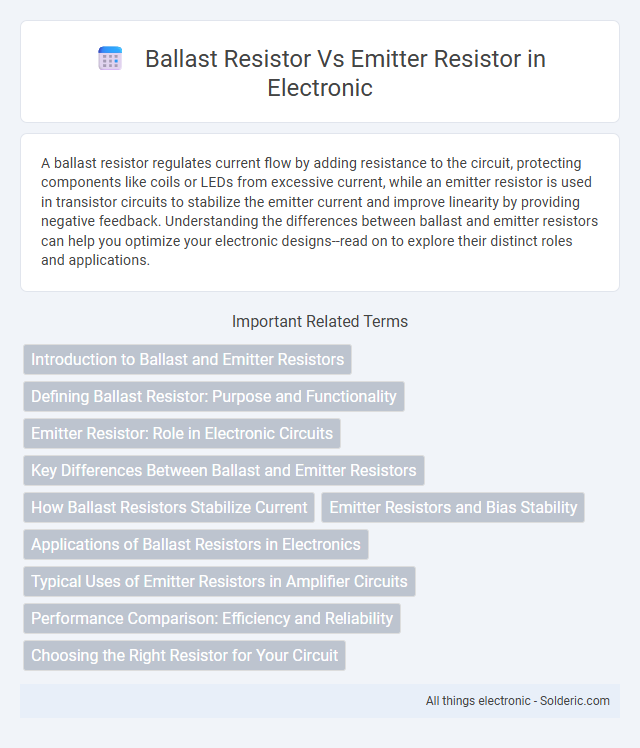A ballast resistor regulates current flow by adding resistance to the circuit, protecting components like coils or LEDs from excessive current, while an emitter resistor is used in transistor circuits to stabilize the emitter current and improve linearity by providing negative feedback. Understanding the differences between ballast and emitter resistors can help you optimize your electronic designs--read on to explore their distinct roles and applications.
Comparison Table
| Feature | Ballast Resistor | Emitter Resistor |
|---|---|---|
| Location | Placed in series with the power supply or transistor base | Placed in the emitter lead of a transistor |
| Purpose | Limits current to prevent transistor damage | Stabilizes transistor operating point (bias stabilization) |
| Effect on Gain | Minimal impact on gain | Reduces voltage gain by introducing negative feedback |
| Temperature Stability | Provides some temperature compensation | Improves thermal stability significantly |
| Common Applications | Simple current limiting in power circuits | Amplifier bias stabilization and linearization |
| Impact on Signal | May cause voltage drop affecting signal amplitude | Improves linearity, reduces distortion |
Introduction to Ballast and Emitter Resistors
Ballast resistors limit current in transistor circuits to prevent thermal runaway, providing stability by dropping voltage as current increases. Emitter resistors are connected to the transistor emitter terminal to stabilize its operating point, improving bias stability and linearity. Both resistors enhance transistor reliability but differ in placement and specific control mechanisms.
Defining Ballast Resistor: Purpose and Functionality
A ballast resistor is a component used primarily in transistor circuits to limit current and stabilize operation by preventing thermal runaway. It achieves this by providing negative feedback, reducing the current as the transistor heats up, thus maintaining consistent performance. Unlike an emitter resistor, which is connected at the emitter terminal to control gain and provide voltage feedback, the ballast resistor is often placed in series with the power supply to protect the circuit from excessive current.
Emitter Resistor: Role in Electronic Circuits
The emitter resistor plays a crucial role in electronic circuits by providing thermal stability and improving linearity in transistor amplifiers. It stabilizes the operating point by developing negative feedback that mitigates variations in current due to temperature changes or transistor parameter shifts. Your circuit's performance benefits from enhanced gain stability and reduced distortion when an emitter resistor is properly implemented.
Key Differences Between Ballast and Emitter Resistors
Ballast resistors are used primarily in lighting and transistor circuits to limit current and stabilize performance by adjusting resistance with temperature changes, while emitter resistors are installed in the emitter leg of a transistor to provide negative feedback, enhancing stability and linearity in amplification. Ballast resistors handle power dissipation and temperature variations directly, whereas emitter resistors influence gain control and bias stability. Understanding these key differences allows you to optimize circuit design for reliability and performance.
How Ballast Resistors Stabilize Current
Ballast resistors stabilize current by providing negative feedback that limits the current flow through a transistor, preventing thermal runaway. As the transistor heats up and its current tries to increase, the voltage drop across the ballast resistor rises, reducing the base-emitter voltage and thus decreasing the current. This self-regulating action ensures consistent operating conditions and protects the transistor from damage.
Emitter Resistors and Bias Stability
Emitter resistors play a crucial role in enhancing bias stability by providing negative feedback in transistor circuits, which helps maintain consistent operating current despite temperature variations. These resistors reduce thermal runaway risk by stabilizing the transistor's quiescent point, ensuring reliable performance in amplifiers and switching applications. Unlike ballast resistors used primarily for current control in fluorescent lamps, emitter resistors are integral to transistor bias circuits for improving linearity and thermal stability.
Applications of Ballast Resistors in Electronics
Ballast resistors are primarily used in electronics to stabilize current flow in circuits, especially in transistor biasing and fluorescent lamp ballasting to prevent current spikes. You can find ballast resistors in power supplies and amplifiers, where they protect components by absorbing excess voltage and maintaining consistent operating conditions. Their ability to limit current ensures circuit reliability and prolonged component lifespan in various electronic applications.
Typical Uses of Emitter Resistors in Amplifier Circuits
Emitter resistors in amplifier circuits are primarily used to stabilize the transistor's operating point by providing negative feedback, which minimizes thermal runaway and distortion. They improve bias stability and linearity, especially in Class A and Class AB amplifiers, by controlling the emitter current and voltage drop. Typical applications include setting gain, linearizing transistor response, and enhancing overall amplifier reliability and performance.
Performance Comparison: Efficiency and Reliability
Ballast resistors regulate current to protect components but often reduce overall circuit efficiency due to power dissipation, whereas emitter resistors improve transistor stability and linearity, enhancing reliability without significant efficiency loss. Emitter resistors provide better thermal runaway prevention and consistent gain, making them preferable in high-performance and high-reliability applications. Your choice between the two impacts both energy efficiency and long-term operational stability of electronic circuits.
Choosing the Right Resistor for Your Circuit
Selecting the right resistor for your circuit depends on the specific function it must perform: ballast resistors are typically used to stabilize current by limiting changes due to temperature variations in devices like fluorescent lamps, while emitter resistors provide voltage stabilization and improve linearity in transistor circuits by controlling emitter current. Emitter resistors help prevent thermal runaway in BJTs by introducing negative feedback, making them essential for amplifier stability, whereas ballast resistors mainly ensure consistent current flow under fluctuating load conditions. Understanding application requirements and circuit behavior guides the choice between ballast and emitter resistors to optimize performance and reliability.
Ballast resistor vs Emitter resistor Infographic

 solderic.com
solderic.com